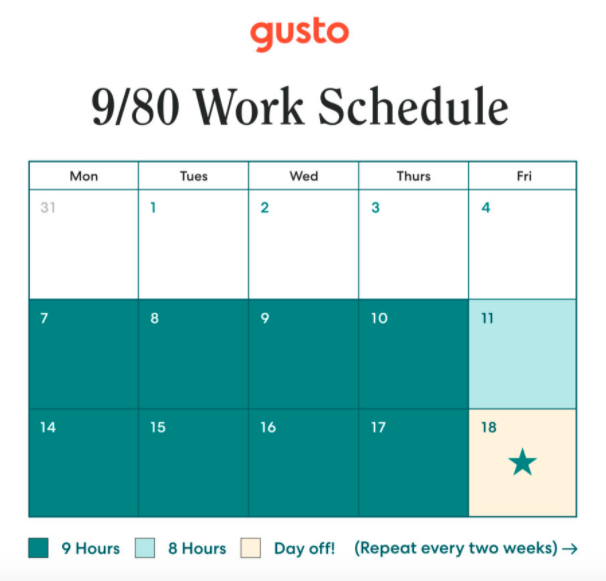Timing Techniques
Batch working or 9/80? How about the Pomodoro Technique? Finding a great workflow takes time and some trial and error, but once you find a strategy that works for you, you’ll have a more productive and happier workday. Let’s dive into the three I mentioned then I’ll share what works for me.
Batch working is when you group like tasks together and focus on their completion before hopping to another task. Instead of multi-tasking throughout your day, switching from sales calls to emails to a marketing project and back again, group your tasks during the week or over a period of time. This can lead to designated days for certain tasks, creating a focused rhythm of work.
A 9/80 schedule works on a two week period. Week one you work four 9-hour days with Friday working 8, week two you also work four 9-hour days but take Friday off. 9/80 basically elongates your Monday-Thursday giving you a 3-day weekend every other week. You are still putting in 80 hours over a two week period, just changing up the typical 40-hour workweek a bit, see below the chart form gusto.

Onto the Pomodoro Technique schedule. Start the day with 25-minute power sessions followed by a 5-minute break. Do about four of these then increase your break time to 15-20 minutes. You’ll definitely need a timer for this, but pomodoros (the interval times) can help drastically break up your day by scheduling sometimes needed distraction time. Here’s a visual from medium.com

I think the best way to find the most comfortable and productive schedule is to try a few out and even combine some tactics. Of course, you also have to think about what type of work you’re in. If you’re in sales like I am, always batching working would be difficult as my days usually incorporate different tasks, some in or out of office. But, I do batch work by grouping together operational tasks to one day a week, usually mid-week which gives Kristin and me time to complete needed ops tasks by COB Friday if needed. Although the 9/80 schedule would give me a 3-day weekend (who wouldn’t want that) it’s not something I want to do right now as a new business owner, even though longer hours are no stranger to me. As far as the Pomodoro Technique, this personally wouldn’t work well for how I like to operate. So here are the two techniques I like to use: 90/20 and MIT.
90/20 = 90 minutes of work, 20-minute break time, repeat. I was surprised at how fast an hour and a half goes when you’re totally focused on work (and you love your job, that’s key). This schedule works well for me because I can get a lot done during these work intervals. Since Kristin and I are working from home, we’re doing a lot of calls/emails/LinkedIns and yes if I don’t focus, it’s easy to drag those calls out during the day. I recently started the 90/20 and had a true realization of how much time I wasted before. Glad I made the switch.
The MIT (Most Important Task) method is exactly as it sounds, rank your tasks, and get the most important done. Choose 1-3 depending on their length of completion time and let that be your focus for the day. Instead of making a massive list that is unattainable, MIT is your way to divide and conquer. This technique was something I always did, big to-do list person here, just didn’t know the strategy had a name. We also incorporate this method during our operations days, usually packing in 3-5 each though.
Any workday technique I didn’t mention but works for you? Let us know!
Written by Eva Gerrits







Leave A Comment